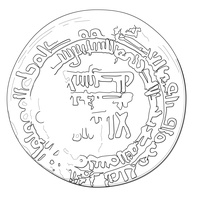
Viking Designs
Drawing of an Arabic Coin
Drawing of an Arabic silver dirham minted in the Middle East and probably brought to Lincolnshire by Viking traders. The dirham was a unit of weight used across North Africa, the Middle East, and Persia, with varying values which also referred to the type of coins used in the Middle East during the Viking Age. These coins were extremely prized possessions not only for their silver value but as a way of displaying one’s wealth and vast trade connections. Millions of Arabic Dirhams would have been imported throughout the Viking world and are mostly found in hoards. Arabic dirhams demonstrate contact between the Viking diaspora and the Arabic world. Arabic coins are especially useful for dating sites, because they carry the date when they were minted. This permits precise dating where the part of the coin with the date survives, whereas European coins can only be dated to the reign of the ruler depicted on them. In western descriptions of these coins, the Arabic dates found on the coins are usually listed in square brackets, as above, and the European equivalent is listed after it.
Read More
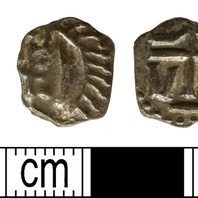
Viking Objects
Merovingian Denier (DENO-4A202A)
This is a silver denier produced by the Merovingian Franks around 700 to 750 at the mint of Marseille. It is possible that it made its way to England prior to Viking incursions but it is equally likely that the Vikings brought this coin with them as plunder after raiding in Frankia.
Read More
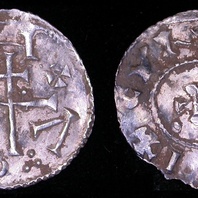
Viking Objects
Viking Silver Penny (LEIC-B230B8)
This silver ‘Cunnetti’ penny comes from the Viking kingdom of York and was minted on the authority of ‘Cnut of Northumbria’. Minting coins was a way of controlling the means of exchange within a kingdom and which created a more easily administered standardized system of trade. Moreover, the coins themselves were often used as propaganda, portraying symbols and statements that gave off a desired message. The Vikings later used the minting of coins to legitimize their own rule.
Read More
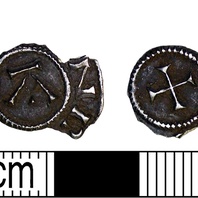
Viking Objects
St. Edmund Penny (LEIC-8D0E07)
Between 895 and 915, Scandinavian settlers in East Anglia minted a series of pennies and half pennies with the inscription SCE EADMVND REX (St Edmund the king). These coins appear to have been used widely throughout the Danelaw, and a large number of them were discovered in the Cuerdale Hoard from Lancashire. This coin appears to have been made with a poorly engraved die and features a blundered inscription naming the moneyer. The Portable Antiquities Scheme suggests that the moneyer’s name was Winegar. The inscription reads YVINRE NO.
Read More
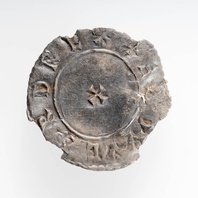
Viking Objects
Edward the Elder Penny (CM.616-1998)
A silver Horizontal type (HT1) penny of Edward the Elder (c. 874-924) minted in London by Garead. Edward was the son of Alfred the Great and succeeded him as king of Wessex. This coin was part of a hoard of twelve coins found at Thurcaston between 1992 and 2000. The coins are Anglo-Saxon, Arabic and Viking issues, and show the diverse and wide-ranging contacts between societies at this time. The hoard was probably deposited c.923-925, approximately five years after Leicester had been retaken by Mercia (c.918). They indicate that a bullion economy was still operating in the Danelaw as late as the 920s. This suggests that the reconquest did not manage to institute Anglo-Saxon practices such as a monetary economy immediately.
Read More
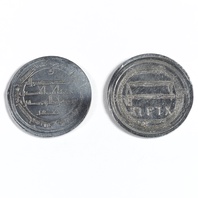
Viking Objects
Reproduction Arabic Silver Dirham
The dirham was a unit of weight used across North Africa, the Middle East, and Persia, with varying values which also referred to the type of coins used in the Middle East during the Viking Age. These coins were extremely prized possessions not only for their silver value but as a way of displaying one’s wealth and vast trade connections. Millions of Arabic Dirhams would have been imported throughout the Viking world and are mostly found in hoards. Arabic coins are especially useful for dating sites, because they carry the date when they were minted. This permits a more accurate dating where the part of the coin with the date survives, whereas European coins can only be dated to the reign of the ruler depicted on them. However, it is also necessary to allow for the time it took the coin to reach the site. In western descriptions of these coins, the Arabic dates found on the coins are usually listed in square brackets, as above, and the European equivalent is listed after it.
Read More
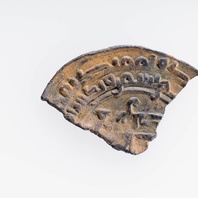
Viking Objects
Samanid Dirham Fragment (CM.840-2002)
This is a silver dirham which was minted during the reign of the Samanid ruler Akhmad Ibn Ismail (907-14) or Nasr ibn Ahmed (914-43) in Samarkand. The dirham was a unit of weight used across North Africa, the Middle East, and Persia, with varying values which also referred to the type of coins used in the Middle East during the Viking Age. These coins were extremely prized possessions not only for their silver value but as a way of displaying ones wealth, status, and vast trade connections. Millions of Arabic Dirhams would have been imported throughout the Viking world and are mostly found in hoards. Arabic coins are especially useful for dating sites, because they carry the date when they were minted. This permits precise dating where the part of the coin with the date survives, whereas European coins can only be dated to the reign of the ruler depicted on them. In western descriptions of these coins, the Arabic dates found on the coins are usually listed in square brackets, as above, and the European equivalent is listed after it. This coin was part of a hoard of twelve coins found at Thurcaston between 1992 and 2000. The coins are Anglo-Saxon, Arabic and Viking issues, and show the diverse and wide-ranging contacts between societies at this time. The hoard was probably deposited c.923-925 CE, approximately five years after Leicester had been retaken by Mercia (c.918 CE). They indicate that a bullion economy was still operating in the Danelaw as late as the 920s. This suggests that the reconquest did not manage to institute Anglo-Saxon practices such as a monetary economy immediately.
Read More
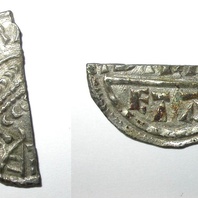
Viking Objects
Coin of Burghred of Mercia (1989-58/3723)
A silver penny of Burghred of Mercia, found in the mass grave at Repton, minted by the moneyer Dudda, probably in London. Burghred was king of Mercia from 852-874 CE. He was driven out of Mercia by the Vikings during their march from Lindsey to Repton in 874 after they sacked Tamworth. Burghred fled to Rome, where he eventually died, and was replaced by Ceowulf II who was loyal to the Vikings. Minting coins was a way of controlling the means of exchange within a kingdom and which created a more easily administered standardized system of trade. Moreover, the coins themselves were often used as propaganda, portaying symbols and statements that gave off a desired message. The Vikings later used the minting of coins to legitimize their own rule.
Read More
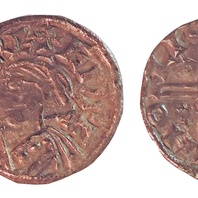
Viking Objects
Northumbrian Penny (NLM-0D491E)
This silver penny was minted in the name of King Eanred of Northumbria. The obverse shows a possibly helmeted and cuirassed individual and reads +EANRE AD RE; the initial cross doubles as X. The reverse reads +CO/ER/[?I]/HO/LI. This particular example was likely brought to Nottinghamshire from Northumbria by means of the Great Army’s overwintering activities in and around Nottingham.
Read More
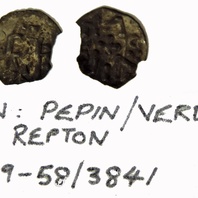
Viking Objects
Coin of Pepin III (1989-58/3841)
This is a silver denier of Pepin III, also known as ‘the Short’ (King of the Franks 751-768), minted at Verdun. The Vikings would have obtained real and imitation Carolingian coins through their raiding and trading activities in the Frankish Empire.
Read More
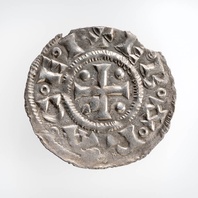
Viking Objects
Northumbrian Viking Penny (CM.952-2000)
This Sword St. Peter type silver penny is not associated with any particular ruler but was minted in the Viking kingdom of Northumbria. The coin features a sword image which is usually considered to represent the sword of St Peter, whose name features on the same side of the coin, and a hammer which is often taken to be Thor’s hammer, thus mixing the iconography of the Christian and Norse religions. It was found as part of the Thurcaston hoard which was probably buried c.923-925 CE, approximately five years after Leicester had been retaken by Mercia (c.918). The coins in the hoard are Anglo-Saxon, Arabic and Danelaw issues, showing the wide-ranging contacts between societies at this time. After the establishment of the Danelaw, some Viking leaders decided to mint their own coins to solidify their legitimacy in the eyes of the local populace. This created a hybrid economy where some members of the Danelaw used bullion and others used coins. The bullion economy resulted in some coins being cut into pieces to pay for items.
